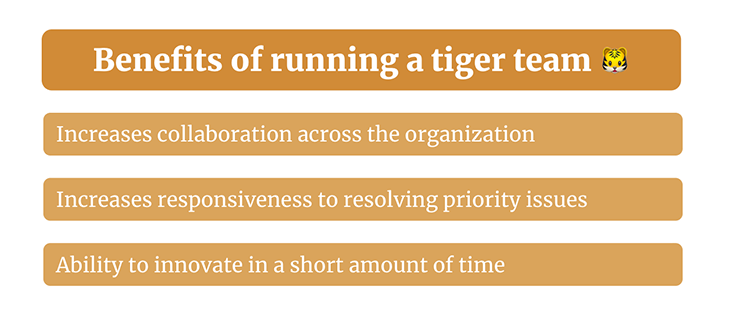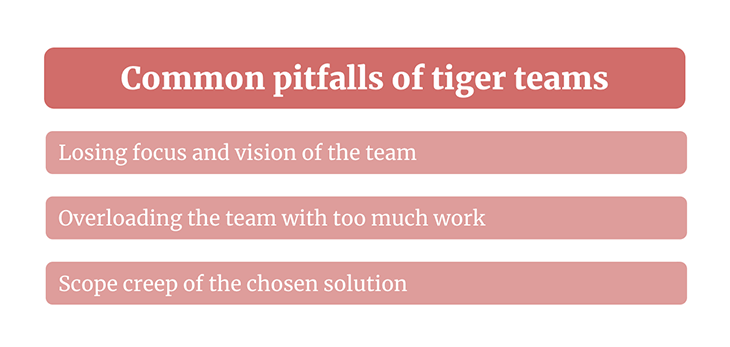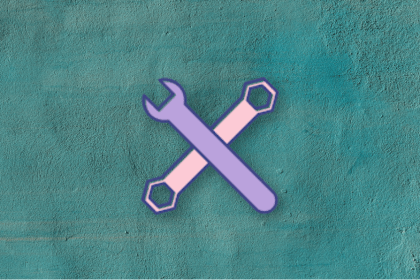In the tech industry, various types of problems arise that need to be solved. Some are deeply entrenched and long-running issues, requiring a large commitment and an extended time frame to resolve. Others might be critical or immediate, necessitating the talents of different individuals across the organization to solve them within a limited amount of time.

As a product manager, it is essential not only to identify when these problems might occur but also to determine the type of talent required to fix the problem and the necessary time frame. Depending on the urgency, priority, and specialized nature of the problem, there might be a need to assemble a “tiger team” to solve it as quickly and efficiently as possible.
In this article, we will discuss what a tiger team is, the benefits of running a tiger team, when to use them, key steps to take to solve a problem using a tiger team, and more.
A tiger team consists of a group of experts and specialists from various fields and functions who collaborate together to solve a specific, pertinent, or prioritized problem.
Originally conceived in military contexts in the 1960s and 1970s, the concept of “tiger teams” entered the public sphere when NASA created its own tiger team to assist with bringing Apollo 13 — and all the astronauts aboard it — back home safely.
Similar to the approach taken by agile release teams (ARTs), the purpose of a tiger team is to break down walls and silos that companies naturally put up between their specialized functions, allowing for closer collaboration and timely problem-solving within a short time period.
A tiger team can be formed on its own to solve a time-critical issue — for example, there is a crippling bug stopping your customers from using your product that requires expertise from different functions in order to resolve it promptly. Alternatively, a tiger team can be formed as a “project” running in parallel with team members’ day-to-day responsibilities. This is usually the case when the organization is exploring a new idea or feature they’d like to add to the product and requires a “skunkworks” or tiger team to investigate the space before committing further resources.
Though they can both sound like fancy buzzwords, tiger team and a task force are not the same thing. Task forces are generally larger, cross-functional groups formed to work on long-term projects. They are structured to tackle more extensive tasks that span multiple areas of an organization and might require more time to resolve. Tiger teams, on the other hand, are specifically focused on resolving immediate, critical problems with their specific expertise.
So, how does an organization know when they need to use a tiger team vs. a task force? The choice between the two depends on the nature of the problem, its urgency, and the scope of the resolution.
| Tiger team | Task force | |
| Purpose | Solves immediate, critical problems | Addresses broader, long-term issues or projects |
| Team size | Small, typically consisting of experts | Larger, with representatives from various departments |
| Scope | Specific and narrowly focused | Broad and comprehensive |
| Duration | Short-term, often for rapid problem-solving | Mid to long-term, depending on the task |
| Cross-functional nature | Mostly experts in specific areas | Variety of functional backgrounds |
Let’s give an example to illustrate how an organization could use a tiger team. Imagine you’re a product manager working for an e-commerce company that suddenly experiences an unusual surge in fraudulent transactions. The issue is immediate and specific, and suddenly the team is trying to figure out how all of these fraudulent transactions are going through..
You jump into action and assemble a tiger team of a data analyst, a cybersecurity expert, a backend developer, and a member from the legal department. This team’s task is to rapidly identify the source of the fraud, implement countermeasures, and create new procedures that will help prevent this from happening again.
This focused, cross-functional approach using a tiger team allows your company to resolve the issue quickly without disrupting the company’s day-to-day operations.
The following are benefits of running a tiger team:

A tiger team comprises various experts from across the organization, bringing diverse knowledge and specialties. Team members work together in one team and can leverage each other’s distinct skills to solve time-critical problems or engage in time-poor discovery in an area of interest for the organization.
One reason for forming tiger teams is to respond to time-critical problems or issues that the company faces. The urgency is fed into the mission of tiger teams, who are given the freedom to focus exclusively on solving the problem within a short amount of time.
When a tiger team runs in parallel with day-to-day teams — for example, conducting deep discovery in an area of investment interest for the company — this helps achieve innovation outcomes at a rapid pace due to increased collaboration and focus.
To determine whether you should use a tiger team, consider if any or a combination of these questions apply:
As a product manager within a tiger team, your responsibility is to guide the various experts, lead discussions, and ensure that each member collaborates effectively and promptly to solve the issue or answer the research question.
The following steps may be undertaken by the product manager to successfully facilitate and guide a tiger team:
When implemented effectively, a well-run tiger team is empowered to solve any problem or answer any question. However, any one of the following pitfalls may derail what the tiger team is meant to achieve:

Due to the diverse backgrounds of individuals in a tiger team, the product manager is responsible for ensuring that each member’s views and opinions are respected while maintaining the overall drive and focus.
Losing control of the room or allowing individuals to work independently rather than collaboratively can endanger the team’s focus and result in losing a key strength.
This is a significant risk, particularly for tiger teams running in parallel with members’ day-to-day responsibilities. A product manager should delegate tasks and ensure that everyone maintains a manageable workload to keep the tiger team nimble and focused on solving the problem without being overwhelmed by their usual tasks.
A product manager can help scope the intended solution or prototype that comes out of the assumptions or discovery phase. Without appropriate scoping, scope creep can distract the team from solving the real problem or lead them down the wrong line of questioning.
It is essential for the product manager to put appropriate boundaries in place to ensure that any investigation or development of the solution does not encompass unrelated areas.
By following these tips, you’ll be able to set up and manage your own successful tiger team in no time. Keep these guidelines in mind as you navigate through various challenges, and your tiger team will be well-equipped to tackle time-critical problems and drive innovation within your organization. Until next time!
Featured image source: IconScout

LogRocket identifies friction points in the user experience so you can make informed decisions about product and design changes that must happen to hit your goals.
With LogRocket, you can understand the scope of the issues affecting your product and prioritize the changes that need to be made. LogRocket simplifies workflows by allowing Engineering, Product, UX, and Design teams to work from the same data as you, eliminating any confusion about what needs to be done.
Get your teams on the same page — try LogRocket today.

Stop letting unreliable data block features. Treat data as inventory to track quality, ownership, and ship with confidence.

Learn why slide decks slow teams down and explore better tools like whiteboards, PRDs, and prototypes to improve collaboration and alignment.

AI PM roles are evolving fast. Learn the five types of AI PMs, the skills they need, and how they shape AI products across industries.

Learn how you can use AI agents to automate workflows, boost productivity, and choose the right tools while avoiding common pitfalls.